Of Trunk and Triumph
Published October 2022
By Karlie Ybarra | Photos by Lori Duckworth | 17 min read
Itʼs a typical April day in lush southeastern Oklahoma, and it’s already muggy and creeping up to hot at ten in the morning. Fifty people of all ages have driven hours from Oklahoma City, Tulsa, Texas, and even Missouri to Hugo, a town of about 5,000 people—and eleven elephants. Giddy anticipation bubbles through the crowd of visitors as they climb onto what look like extended golf carts that ferry them beyond a set of tall metal gates.
It took Kasa Holtfrerich and her husband Matthew almost a full tank of gas to get here from Norman. Spurred by a Facebook post and a recommendation from a friend, Kasa knew she wanted to spend her birthday here visiting the Endangered Ark Foundation, but she didn’t quite know what to expect.
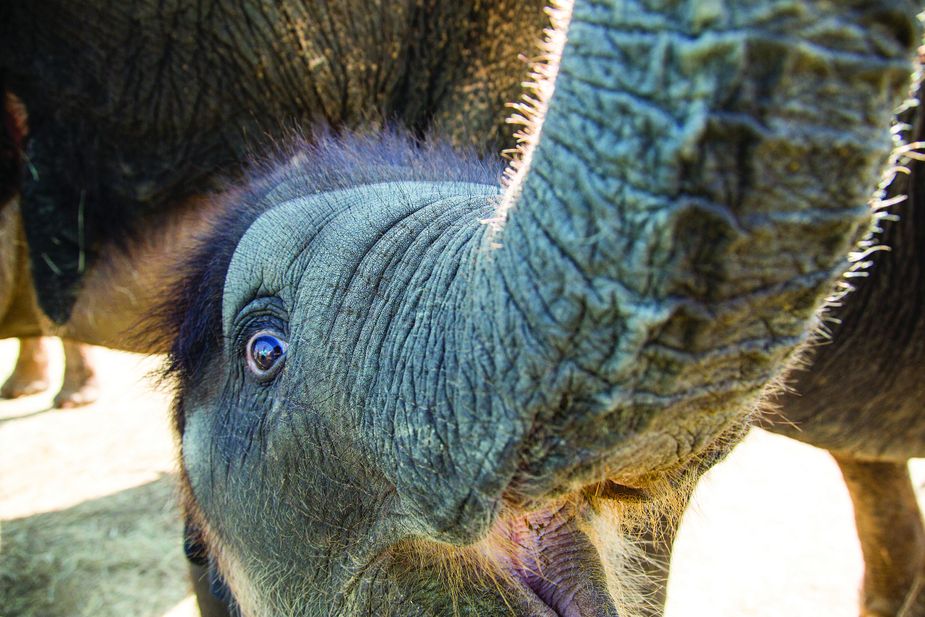
While some of the elephants at the Endangered Ark Foundation in Hugo were born in Thailand and brought to North America as calves, many—including two-year-old Dori Marie, here—were born in Oklahoma.
“When we’re first brought in, we take a seat on some bleachers, and literally right next to us is a baby elephant and her mom,” she says.
Not ten feet away, Dori Marie, a two-year-old, 1,358-pound calf covered in tufts of wiry red hair, pesters her 6,368-pound mother Whimpy in that adorably irritating manner all toddlers quickly master. Beleaguered but ever patient, Whimpy wraps her trunk around a bundle of fresh hay and pops it into her mouth as her little one scuttles around.
The elephants barely react to the crowd of onlookers, who by this point are either squealing with glee or gaping in awe. The Endangered Ark Foundation has been Whimpy’s home for twenty-four years; it’ll be Dori’s for the next sixty or so, just like it will be for a handful of other Asian elephants including Suzie, Obert, Hugo, and Lillie. In addition to providing a sanctuary for these eleven pachyderms, the Endangered Ark Foundation is dedicated to preserving, conserving, and educating the public about these animals.
“We want people to be able to fall even deeper in love with elephants so they can be empowered and ask what they can do to help,” says Arlinda Copeland, foundation director.
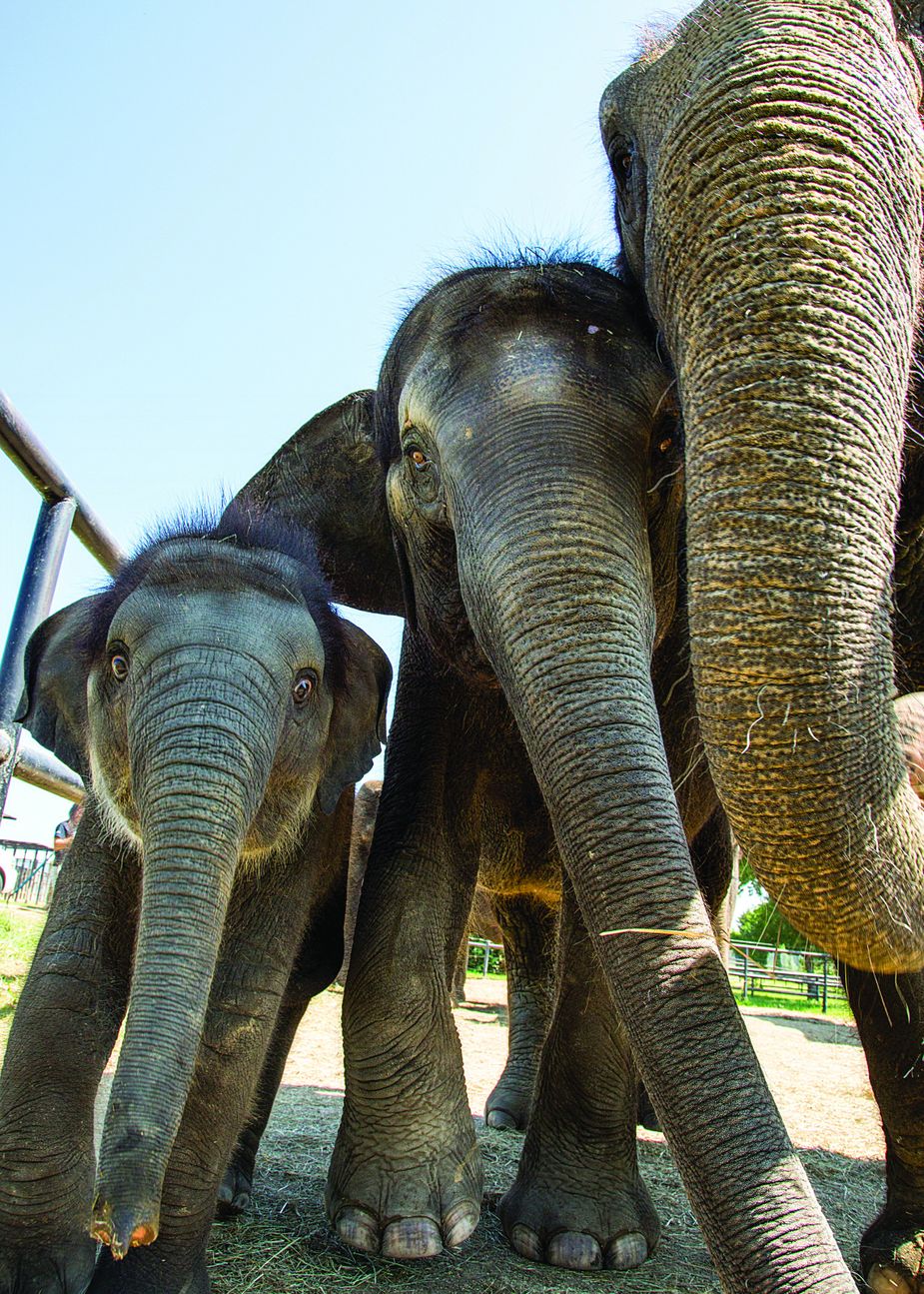
Asian elephants have a single digit on their trunks—unlike African elephants, which have two. Both subspecies’ appendages contain 150,000 muscles.
But before the sanctuary was opened, before any of the residents were even born, it was a love of elephants that led D.R. and Isla Miller on an unconventional path to Hugo.
From the age of sixteen, there were three loves in D.R. Miller’s life: the circus, elephants, and his wife-to-be, Isla Marie. Once they were married, it didn’t take him long to bring the three together.
“They went off with the circus,” said D.R. and Isla’s daughter Barbara Miller Byrd in a 2011 interview for the Big Top oral history project conducted by Oklahoma State University about occupations related to traveling circuses. “Mother had never even been out of the county. That first night they were together, they stayed in a pup tent, and she ended up having chicken pox. It must have been frightening, lying in that pup tent with chicken pox, listening to the lions roaring.”
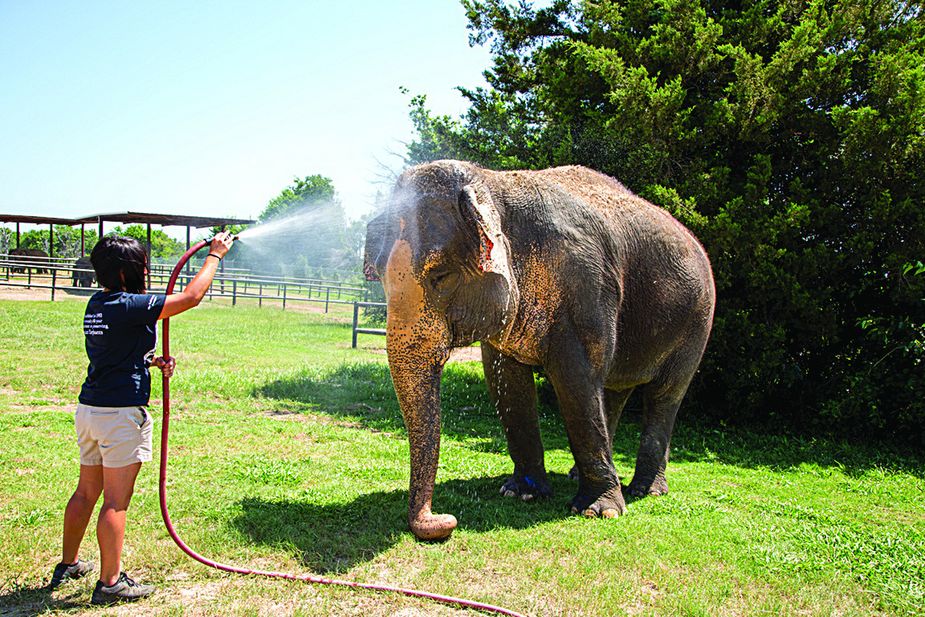
Baths are a daily ritual for all elephants at Endangered Ark.
Soon, Isla learned to perform alongside her husband, and they began growing their act and touring the country. As they gradually moved their home base farther south from Kansas to avoid the harsh winters, it was a local businessman and circus fan who persuaded them to move to Hugo in 1941.
“Mr. Pratt owned the big grocery store, and he talked them into coming from Arkansas to Hugo with the promise of free water,” Byrd said. “The first winter, they parked at Pratt’s building and lived in a trailer with their elephant. Then, they bought a farm, and the elephant got a new barn. My mother joked that the elephant got a house before she did.”
The Millers became known across North America for their ability to put on a spectacle, and their herd of elephants played no small part. At one time, their Carson & Barnes Circus had more than fifty elephants, many of whom performed and helped with day-to-day operations.
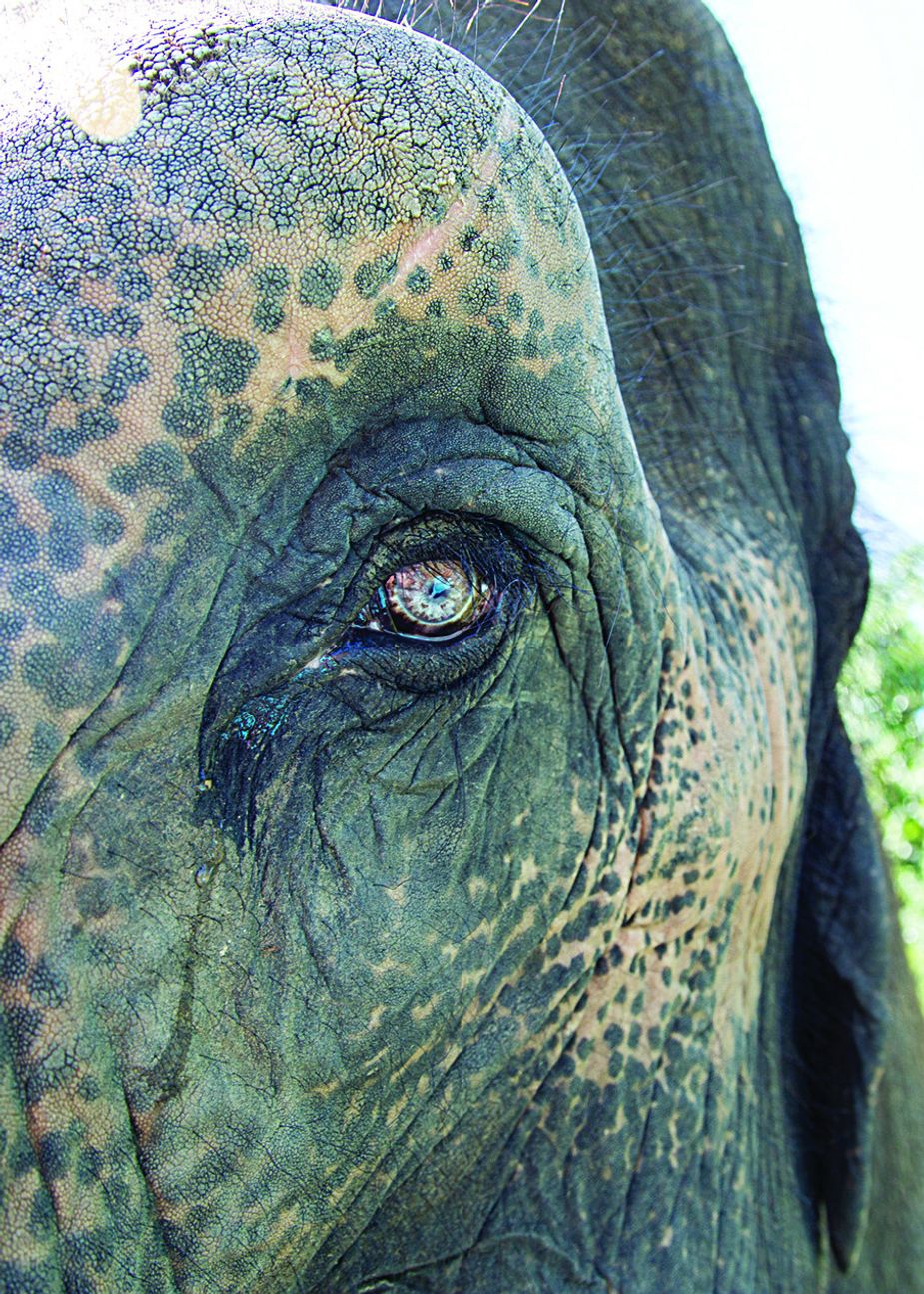
It's estimated that there are fewer than 40,000 Asian elephants left on Earth, a third of which are in captivity.
“Barbara the elephant would pick up the seats; I’d tell her when to back up, and where to set them down,” said Mike Fulton, a long-time Carson & Barnes employee in a Big Top project interview. “We’d use the elephants everywhere we could, and they loved doing it.”
But for D.R., these animals weren’t simply part of the show. They were part of the family. He doted on them as any father would.
“When he got his first elephant, he was so proud,” Byrd said. “He loved them.”
D.R., Isla, and eventually their daughter Barbara and granddaughters
Kristin and Traci continued showcasing their talented cast for the next five decades. But traveling and performing year after year can take a toll on animals. So in 1993, the Millers donated their Hugo property to establish the nonprofit Endangered Ark Foundation.
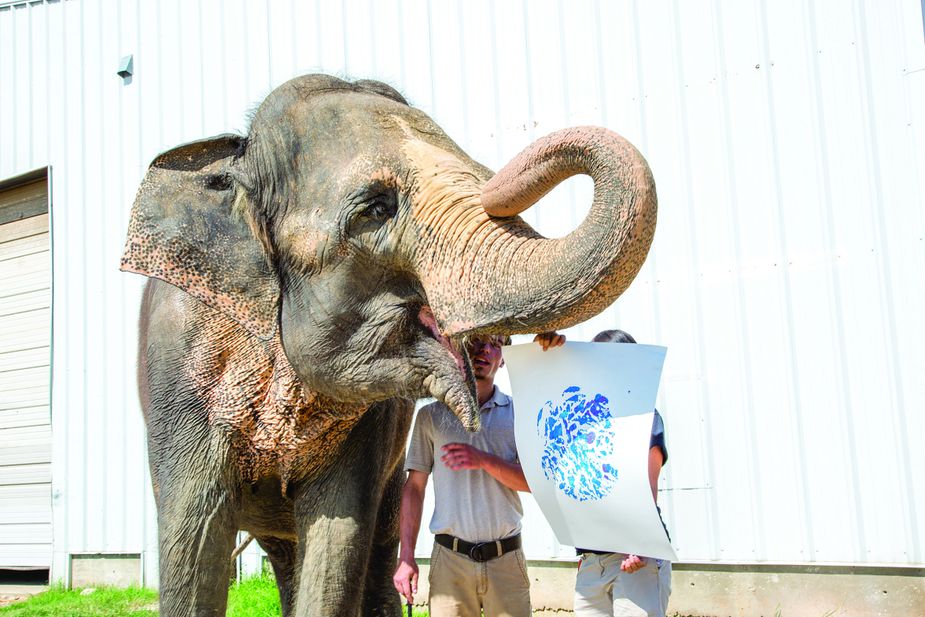
As part of their enrichment, elephants paint using their trunks or feet. Visitors can purchase the art to help support the Endangered Ark Foundation.
“As the herd got older, they saw a need for a place to retire and spend the rest of their lives without any worries,” says Kristin Parra, D.R. and Isla’s granddaughter and a member of Endangered Ark’s board.
Two hundred acres of green fields for grazing, wooded copses for foraging, and a creek for wallowing: not a bad retirement home. And there they stayed, content in their hidden sanctuary for the next twenty-one years. But by 2014, the world had changed. The state of Asian elephants in captivity in North America was, at best, unsure.
“Experts predict that by 2050, there won’t be any Asian elephants left in North America,” Parra says.
In the wild, things were dire.
“Asian elephants’ native range has diminished by 75 percent in the last fifteen years,” Copeland says.
And the endowment D.R. left the foundation upon his death in 1999 had run out.
“It costs $38,000 a year to care for each elephant,” Copeland says. “We currently have eleven elephants, so it’s quite costly.”
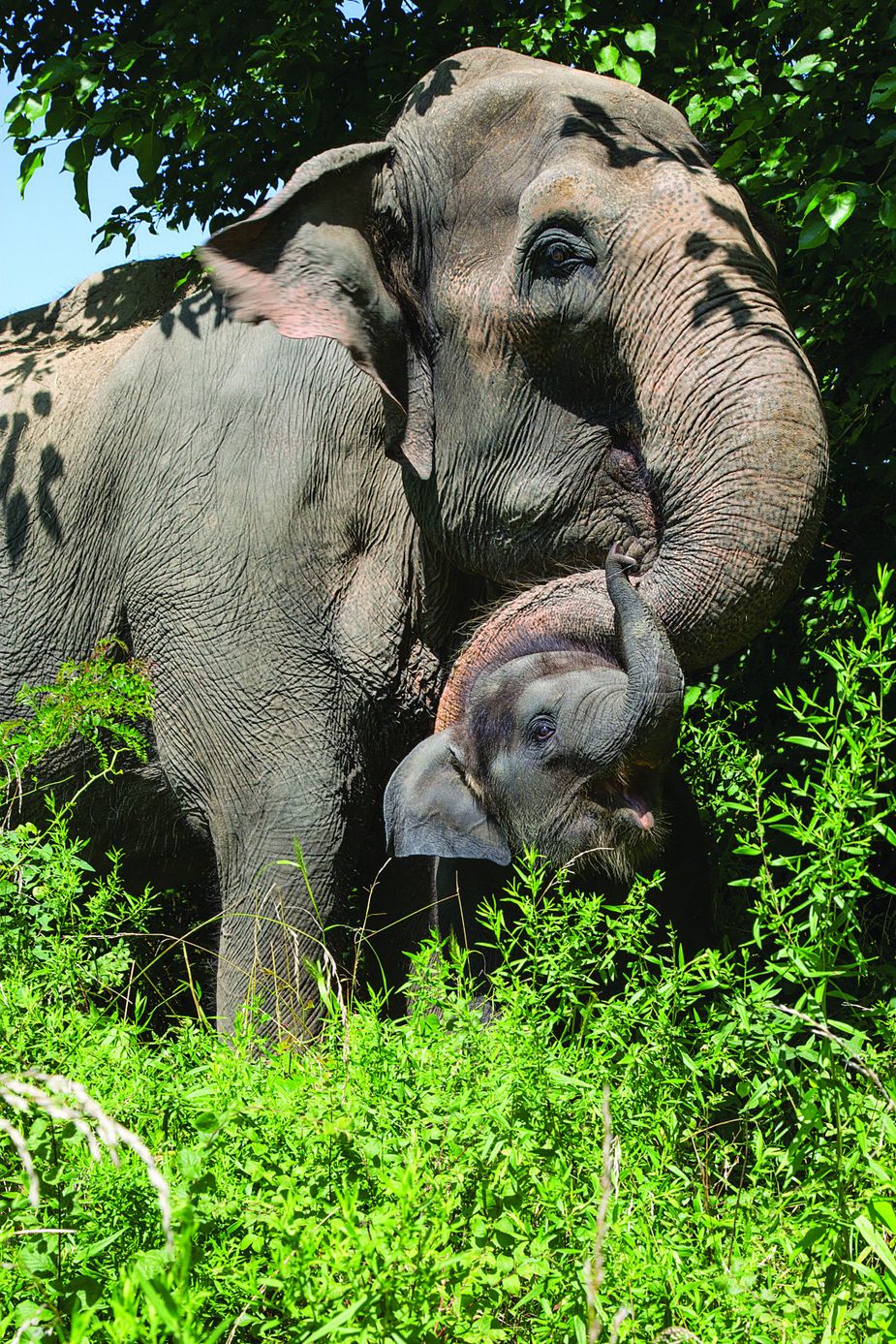
When Dori was born two years ago, she weighed 328 pounds.
The Endangered Ark Foundation board decided the elephants of Hugo would come out of hiding, and the world would start coming to them.
Everyone has taken a seat on the bleachers and mostly recovered their wits after their initial elephant sighting, although as Copeland tells the story of the Endangered Ark Foundation and shares facts about Asian elephants, the crowd’s peripheral attention remains on the mother and daughter pair standing nearby.
“Elephants carry for twenty to twenty-two months, and their babies nurse for two years, so at optimal conditions, they can have a calf every five years,” she says. “Now does anybody know what elephants eat?”
As Copeland speaks, one of the Ark’s handlers begins making his way over with a couple of pachyderms following behind.
“Our elephants eat 100 to 150 pounds of food a day, including hay, elephant feed, fruit, and vegetables,” she says. “During the summer, we like to show how they eat watermelon. Elephants have preferences like humans. Some will stomp watermelon, some will put it in their mouth and chomp down, and another one will wrap its trunk around it and crush it.”
By this time, all eyes have shifted from Copeland to the creatures standing behind her.
“This is Del Rita, and this is Rosie,” Copeland says, pointing to her immediate right then back to her left. “Many humans have geriatric issues as they get older, and elephants are the same. So we try to create specialized enrichment activities that will enhance their quality of life. We even do elephant yoga.”
The cliché “like a duck to water” perhaps could be replaced with, “like an elephant to yoga.” Even knowing these animals once performed under the big top, it’s amazing to see how gracefully Del Rita stretches her legs to touch a moving ball at the end of a stick or how playfully Rosie tosses a ball with her trunk in order to get at the fruit hidden inside.
“Through word association, repetition, conditioning, and reward, we help exercise their joints and trunks in order to extend their range of motion,” Copeland says.
But it’s the pampering that comes after the yoga class that gets both the crowd and the elephants the most excited.

Quite the curious toddler, Dori often will stick her trunk into the other elephants’ mouths to investigate what they’re eating
“I bet y’all didn’t know we had a spa here,” Copeland says.
Proper foot care is vital to elephants’ survival, and Del Rita is more than happy to prop hers up on a platform for her daily pedicure. As the handler cleans and files Del Rita’s toenails, Copeland turns back to the crowd.
“I heard there were a couple of birthday girls here,” she says. “Would you like to help with another spa treatment?”
This was the moment Kasa Holtfrerich had hoped for but never thought would actually happen.
“They let us help give Del Rita a bath,” Holtfrerich says. “They showed us the special soap they use and how they bathe them. And then I got to scrub her down and feel her rough skin. It was so special.”
According to experts, it’s not anthropomorphizing to say that Del Rita probably enjoyed this experience as well. Scientists have found evidence over the last ten years that elephants are more mentally complex than previously realized: They are empathetic, can work together to solve problems, and even have a sense of self. Consequently, many question whether elephants should be kept in captivity. But Kay Backues, director of animal health for the Tulsa Zoo and consulting veterinarian for the foundation, says that when the animals are this well-cared-for, close-up encounters can provide an invaluable educational experience.
“If we didn’t have these populations like the Endangered Ark Foundation, I don’t think the average person would ever get to see an elephant,” she says. “I don’t think if you see pictures of these animals, you can really grasp their size, strength, presence, and who they are and what they’re capable of. That’s a tragedy I don’t want to happen.”
The sun has come out from behind the clouds. People are starting to sweat, but there’s one more stop on the tour. Once again, the visitors are herded onto their trolley. The driver stops short of a fence deep in the heart of the Ark’s grounds, and Lillie and Suzie emerge from the tall grass.
“Would you like to feed them?” Copeland asks.
Copeland and her staff hand out carrots for Lillie and bananas for Suzie, the herd’s matriarch, whose teeth are a little worn down. One group at a time offers a treat in exchange for some face time. Neither elephant seems to mind as people pet them, take selfies, touch their trunks, and kiss them on their wrinkled faces.
“We want to give people the opportunity to come and connect with the animals and learn about their struggles, to see them up close and fall in love with them,” Kristin Parra says.
As the visitors begin their drive home from Hugo, it’s hard to say what they took away from their experience. Maybe it was more knowledge about elephant anatomy. Maybe it was inspiration to support a charity working to save these majestic creatures. Maybe it was cute photos and a cool story. But one thing is for sure: Once they’ve met Dori or Del Rita or Suzie or any of the other residents of the Endangered Ark, that feeling of appreciation for something larger than themselves is something they’ll never forget.
The Endangered Ark Foundation offers tours to the public each Friday and Saturday. Adults are $30, and children four to twelve are $15. Private tours are by appointment only and start at $300 for a group of five. Hugo will host its annual Pumpkin Festival October 5-29, which will feature elephant events to help raise money for the foundation.

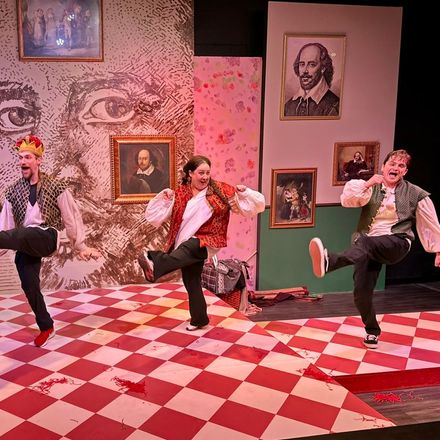

.png)



